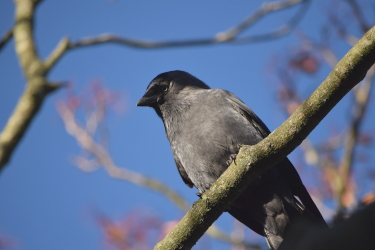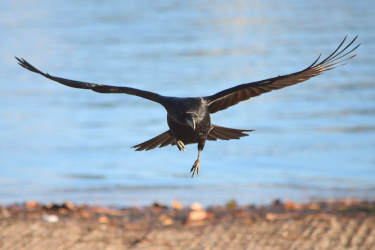Cédric Beaume
Applied Mathematician
You are in Beaumian Motion > My part in a murder
My part in a murder
Murder: a flock of crows (Merriam-Webster).
Chapter 1: The trigger
11/06/25: Jackdaw daddy
A fledgling jackdaw was trapped in a neighbor's front yard with no way out except through flight. Despite the many calls of encouragement from its parents, it spent the entire afternoon on the ground and its discouragement was obvious. I went to help and, with a bit of patience, managed to make it climb on my arm. Thanks to its new-found elevation, it became curious about its surroundings and expressed itself in a way that was familiar to me. When Kimie, my hand-raised cockatiel, was curious about something, she stretched her neck toward it, tightened her grip on my finger or arm and twisted it accordingly. This became standard non-verbal communication between us. As the jackdaw acted similarly, my response was prompt: I moved it in the direction of its interest. I believe this unexpected act of coordination built its confidence. Its inhibition progressively faded to the point it regained interest in taking flight. It stretched upward. I responded by moving my arm upward. When it relaxed, I moved my arm downward. After a small hesitation, it started again. We went through two similar cycles, amplifying the motion during the second one. On the third cycle, I threw my arm and it jumped off. The jackdaw's flight covered a few tens of meters and it perched against a first floor window across the street. Success! I helped a jackdaw take its first flight.
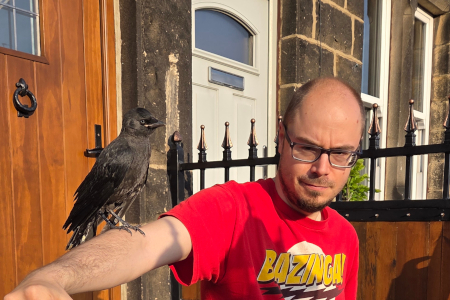
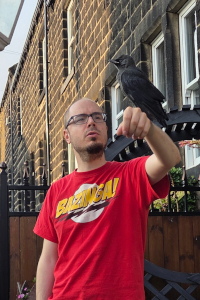
Playing jackdaw daddy (doh dah dee, doh dah dee doo 🎶).
Chapter 2: Meeting corvids
13/06/25: Beginner's luck
On a whim and after reading a number of online accounts claiming that feeding wild corvids peanuts is easy and rewarding, I decided to buy a bag of redskin peanuts. After crossing the street from the grocery store, I stumbled upon a crow with the attitude of a sidewalk sovereign. I grabbed the newly bought treats, scattered three of them on the ground before me and backed off against the wall. Without hesitation, the corvid ate the first peanut, then grabbed the other two in its beak and flew away with them. This was fun and, indeed, easy.
19/06/25: Neighborhood walks
The two positive experiences of the past week compelled me to take a step further into the corvid world. As the week progressed, my initial errand turned into a well-defined objective: I wanted to befriend a crow. In order to achieve this, I first needed to get their attention. So, I walked around the neighborhood a few times a day with a pouch full of delicious peanuts and, every time I spotted a crow or a jackdaw, I rigidly applied the following protocol:
1. walk to a place near the corvid's perch
2. grab two peanuts–I wanted to appear generous
3. display them while clicking my tongue three times–an auditory signature should improve recognizability and I did not want to imitate a bird call to avoid being misunderstood by the corvids (my neighbors already know I am quirky)
4. place them on the ground in front of me
5. walk away as far as I could while still within sight of the action
6. observe for a few minutes
This did not give me much success and I had to go back to pick up most of my "droppings". I only managed to feed three corvids despite hours of walking and stalking. In fact, the few birds I saw seemed indifferent to my gifts. Were they fully satiated? Or too suspicious to accept food? Did I act inappropriately to them?
20/06/25: It's a crow!
On Thursday evening, while in bed, I had the strange idea of scrambling an egg and leaving it on my driveway for breakfast. I did exactly that the following morning, before even preparing my own breakfast. As I was barely back indoors, a crow landed and ate the egg. Breakthrough! I find it remarkable that the crow could act so quickly: it only took me seconds to place the egg on my driveway and the neighborhood was bustling with commuters. In hindsight, I believe that my client had been perched on the top of a very tall tree quite some distance away but with my driveway in sight. It might have seen me tossing peanuts in the neighborhood during the past few days and awarded me the "interesting human" badge. Who knows, I might, some day, drop tastier snacks.
Later that morning, it perched on a low branch across the street, facing my window, and made a loud structured call. It was irresistible: I dropped work, turned to face it and was immediately locked in, as if it penetrated my soul. Was it the crow's way to thank me? Was it telling its friends that it located a source of food to which it pointed? I wish I knew but, at that moment, I realized that I was being observed and that this crow had my address. It was my turn to be opportunistic. I wanted to make sure that it remained around my property to maximize our interaction frequency. I therefore decided that my driveway would be an abundant source of corvid food for the time being. On the menu today: cooked ground beef leftovers. Unfortunately, during lunchtime, two magpies saw fit to down the first serving. Although they came back once more during the afternoon, they did not prevent my star client from enjoying another human-made meal. It even brought a fellow crow, who remained on the tree. I assume they are a couple.
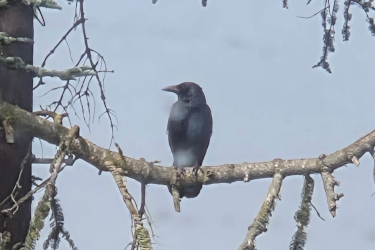
Moments after the crow's eerie call to my window. I was shaken. It likely was not.
Chapter 3: Getting to know my crows
21/06/25: Settling in
My efforts in ensuring that my driveway was a permanent restaurant for crows worked. A crow spent considerable time stationed on a tall tree across the street and was sporadically joined by two others whose behavior suggested recent fledging: they requested food from the elder by leaning forward, beak wide open, shaking their tail and by producing a sound that I can only describe as a loud mixture of a macaw and of a toad call but in a creepy sort of way. I have now a resident crow family.
Unfortunately, during the morning, a gang of four magpies violently assaulted my avian restaurant, unappreciatively swallowing scrambled egg and ground beef. They remained in the neighborhood all afternoon and even recidivated until, in the evening, one of them approached stealthily as a crow was trying to decide whether or not the food was safe. The crow reacted promptly by chasing it away. It looked like an innocuous event but I am sure something took place that only birds can understand because, from that moment, no magpie dared to approach my crow.
28/06/25: Snack ranking
Last Sunday, I set up an experiment to identify the best treat for my crows. A few times a day and mostly on visual or auditory cue, I would provide a small quantity of three different food items and record the order in which they ate them. This was not the first time I ran this experiment: Kimie was my subject about 15 years ago and took perverse care to eat her seeds in a random order, making it nearly impossible for me to learn anything–as any good French bird, however, she did have a soft spot for the crusty end of baguettes. Much to my surprise, crows methodically finished one food item before tackling another and showed great predictability. Here are the results, starting with their preferred snack:
1. Cashew nuts
1. Walnuts
3. Cat food (Purina Go Cat: Duck and Chicken)
4. Hazelnuts
5. Roasted monkey nuts
6. Redskin peanuts–the resident woodpigeon is grateful
I also tested rarer food items. Some of them were absolute treats (raw pork fat, raw lardons and cooked ground beef). These scraps were always chosen first but are either impractical, or unhealthy. Lastly, scrambled eggs obtained unclear results and require further study.
The crow that came to my property on 20 June 2025 was easy to identify. He had gray-colored patches on both wings that seemed to result from a symmetric gap in his feathers, exposing his down. I have been wondering about their cause. I assumed this crow to be a male, given his dominant behavior. During most of the experiment, he was the only diner and has a clear preference for walnuts. The last couple of days of the experiment saw another crow at the table, presumably his female. She, on the other hand, was partial to cashew nuts. This is why walnuts and cashew nuts share the first place above. Last but not least, the fact that my crows deliberately left the redskin peanuts explains my lack of success during my mid-June neighborhood walks. My crows are fancy.
So, from now on, I will have a cupboard full of cashew nuts, walnuts and cat food. I am unsure about what to do regarding hazelnuts and roasted monkey nuts but redskin peanuts will be going to bird feeder frequented by house sparrows, dunnocks, blue tits and coal tits.
20/07/25: Skittish
How would you describe a crow? The first words that come to the mind of most people are "black" and "loud". After a good month of study, my answer would rather be "fascinating" and "frustratingly skittish". Take their matt metallic feeding tray: they only "accidentally" approached it during the first couple of days and it took the better part of a week before they started displaying any casual behavior near it. A month later, they still occasionally scare-jump after grabbing food.
My local crows do not tolerate being looked at when they are on the ground. They overreact theatrically when they feel they are being observed, ceasing their current activity often to adopt a gauging stance, jump or simply fly away. Not only human gaze triggers this behavior, but also camera lenses. Now you know why I cannot take a decent quality photo of these birds. To get them used to me, I decided to remain within sight when they eat. I set up a seat and a table in my garage (more eye-rolling from my neighbors), approximately 6m away and downslope from the feeding tray. During my first garage session, on 27 June 2025, a crow landed, walked around but left the food untouched. The next attempt, a couple of days later, saw a crow daringly grab a single cashew nut before leaving and not returning. On 2 July 2025, however, a crow landed and cawed startlingly loudly in my direction before leaving with a beakful of treats. He returned a few times to empty the tray despite my presence. To this day, my crows are still easily frightened but they would feed in my presence, for as long as I am not moving or staring at them.
Yearling crow scare-jumping after being surprised by the action of its own weight on the tray. |
02/08/25: Encounter with a hard-boiled egg
After noticing changes in feeding pattern (more on that soon), I decided to run the snack ranking experiment again and was not disappointed:
1. Cat food (Purina Go Cat: Duck and Chicken)
2. Cashew nuts
3. Roasted monkey nuts
3. Walnuts
3. Almonds
6. Hazelnuts–they were sometimes left behind, uneaten
In addition, salmon skin was the top pick every time it was provided. They are called carrion crows for a reason, after all. The reason for the changes in ranking compared to the experiment of 28/06/25 is likely that I have been feeding different crows. The early days of the previous experiment saw walnuts top the chart. It could be the male's top pick as he was then feeding the family. Later, a second crow joined him and cashew nuts became favored. I assume this is the female's favorite snack as the fledglings were still dependent on adults to feed. In the current experiment, I may have been feeding an additional two, maybe three, younglings and the results should now represent their tastes, explaining the rise of cat food.
Last week, I challenged my crows with a hard-boiled chicken egg. The result was entertaining. Barely a few minutes after setting up the egg on the feeding tray, a yearling crow appeared. It was visibly its first encounter with a hard-boiled egg and the learning process was captured in the below video. It first studied the egg, then decided to break with it with its dubious technique (keep your beak closed when pecking!). Once broken, the young crow enjoys a meal (despite struggling to hold the egg with its foot) before ultimately deciding to fly away with an uneated egg half.
First encounter of a yearling crow with a hard-boiled chicken egg. |
06/08/25: Optimized squirrels
One of the difficulties I encountered is the presence of unabashed gray squirrels. By now, they have learned that I am a food dispenser and patiently wait in the hedge across the street for me to bring the feeding tray out. They have optimized their behavior to the point that I do no longer have time to get back indoors before they reach the tray. They also adapted their safe distance: when I am more than 3m away, they mind their own business (i.e., eating crow food) but, as soon as I get any closer, they make a dash to grab one last nut before graciously hopping away. Consequently, I cannot scare them away. To mitigate this nuisance, I bought a feeding held by a 60cm pole planted in the lawn. The idea is to provide treats that squirrels do not find appealing (fish skin, cat food, eggs, etc.) on the ground tray, whereas nuts will be placed on the raised tray, out of squirrel reach. So far, I have observed squirrels smelling the nuts from below the tray but none of them dared jumping on it. It is not a win yet, though, the crows are afraid of the tray...
27/08/25: Territory dynamics
I have been feeding a crow family of 4 every day since 20 June. They generally came twice a day, feeding eagerly in the morning between 9am and 11am and more casually in the afternoon between 3pm and 6pm. In the morning of 2 August, as they were perched unusually close to my house, one of them cawed and a loud echo resonated from one of my surveillance cameras–I was carelessly scrolling through settings and must have had it on speaker. The ominous feedback probably scared them as they left before feeding and did not return for days. Or, maybe, it is their neophobia against the new raised feeding tray that kept them away...
In the absence of crows, the magpies returned, this time joined by jackdaws. Another crow family also visited, but only sporadically. Its five members were scared of the metallic feeding tray and their younglings were still annoyingly begging for food, so it seemed a month behind in development compared to my "resident" crow family. Their approach was methodical. First, a single crow landed and walked purposefully everywhere, examining everything with skepticism. The establishment of a perimeter could take a couple of minutes before the crow in command "allowed" the others to land and feed. If a car or a pedestrian passed by, all flew away except the temerous crow who would move sideways only slighlty before resuming its patrol while the others waited in the trees.
My resident crows returned on 16 August, led by a different bird. I recognized it as one of the younglings thanks to its brown hood plumage and to its peculiar behavioral quirk: it likes to walk on the metallic feeding tray while every other bird is scared of it. It developed two partly white primary feathers on its left wing, so I have found myself calling it "Alba". The other youngling sometimes joined. It had a thinner head, used to land on the gutter above my office and had the intriguing propensity to walk on the slanted wall of my outdoor staircase. During its absence, it seemed to have developed gourmet tastes: it likes to drop food into water and periodically check its softness by with its beak. Quite rarely, the parents joined them for snacks.
All of this raised the following questions:
-Why would the resident crows suddenly stop visiting only to return about two weeks later? Crow conference? Summer holiday?
-What caused the change in the alpha-crow from one of the parents to one of the younglings? Is it possible that the family split their territory and gave some to their younglings? Could this even happen when they are so young (I suspect they are yearlings)?
-What could explain the visits of the military crow family while the residents are away? Could my property be on the edge of two crow territories and the second family is a neighbor?
I did not manage to find anything in the scientific literature that could explain what happened, but most of it focuses on the American crow and not the carrion crow, which is my local species.
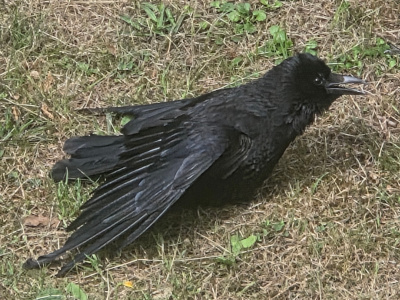
Adult crows sunning on the lawn (Yorkshire birds have the enviable ability to see the sun through the clouds!)
02/09/25: Almond caching
As I happened to look out the window yesterday morning, a crow was eating from the plate I had prepared for breakfast. Almonds seemed to be its main interest. I saw it carry one in its beak to cache it in the ground a few meters away. It held the almond inside its nearly closed beak and energetically pecked once into the soil. The nut was nicely lodged into the ground, slightly below its surface. It covered the barely visible tip of the almond by pulling grass over it. Simple and efficient. At this point, the treasure was perfectly hidden. I decided to wait for the bird departure to take a picture of the work.
As the cacher was back to the plate, another crow landed and spotted me at the window. In the most exuberant avian body language, it flattened its feathers, pulled a long neck and tilted its head to point a stern eye at me. It remained in this position for a few seconds, then walked a few steps, its eye always fixated on me, then stopped again. Only once it left the area, did the cacher walk away from the plate toward a hedge, peck at the ground and unearth another almond. After storing it in its crop, the crow proceeded straight to the cache I could no longer locate exactly. Well, there was no hesitation from the corvid: the nut was recovered and transported away in an instant.
Somehow, the spotter communicated to the cacher that they were being observed, perhaps through body language or very soft vocalization (I heard nothing). Then, the cacher waited for the spotter to leave to recover its stash, probably not to reveal any secret. And now, I know that crows plant nuts in my garden...
15/10/25: Let's play beakball!
While visiting a gift shop in September, I did something I normally never do: I purchased an item. The sight of a bouncy ball reminded me of an account I read in "The Language of Crows" by Westerfield in which someone saw crows play with a bouncy ball on the roof of a shopping mall. I had to have one too. After a couple of days during which my crows looked at their bouncy ball skeptically, they started to engage with it. When they are undisturbed, they tend to play beakball (see video below). But they are very possessive and, when more than one crow wants to play, the first crow generally takes the ball in its beak and flies away with it. I have also witnessed a crow hiding the ball against the sidewalk, below fallen leaves. I wonder where they stash all these balls and what they may do with them.
Crow playing beakball. |
16/11/25: Crow schooling
The fall season led to an amusing phase in the development of my neighboring yearling crows. They were initially not very good at vocalizing, a skill that is fundamental in crow society. Clearly, the yearlings did not have the power to produce long distance calls, nor did they have enough control to appear understandable to their peers, let alone to sound eloquent. So, most of the days in September, at around 5pm, a young lonely crow perched on the tree in front of my office window to practice. The daily recitals were a surprising and enjoyable experience. The crow gurgled, grumbled, mumbled, and made all sorts of other weird sounds that I would have not have associated with crows. They are indeed songbirds, but in a Schönberg kind of way. I assume that these practice sessions allowed the young crow to learn control over its syrinx (which is a more complex instrument than our larynx—remember how difficult it is to learn the sounds of a new language?) while the isolation allows it not to risk being misunderstood by other crows. That being said, let me keep imagining that it seeks isolation to avoid shame.
Around the same time, young crows start to learn social skills through play. The three birds that visited me indulged in the most entertaining of games. They enjoyed windriding together and could do so for long periods at a time. They would perch at the top of a tree, open their wings and let the wind take them. Most of the time, they would control their flight without beating wings and in such a way that they remained above their initial perch. They would sometimes do this in tandem: one bird controled its glide to land on the perching location of the other, who would then take off, use the wind to circle above the perch and dislodge the other bird. They would repeat the manoeuver over and over. In Wales, I saw larger groups of crows play tag, where a designated bird is chased by all the others and the crow that catches it becomes the new target, leading to pleasing aerial choreographies that could last for the better part of an hour.
Back to my local crows, my post of 15/10/25 shows them playing beakball. Bouncy balls were a hit and they would often play with them after finishing the food. Unfortunately, one day, a crow attacked the ball frantically and ate small chips of plastic that came off it. I decided to stop providing balls, worried for their wellbeing. Pistacchios became the next hit. They did not mind them initially. After all, they have an annoying shell to break and the nutritious part is small. But, one day, the curiosity of a crow got the better of it and, now, I regularly see crows playing with leftover pistacchio shells. They move the shell around, hide it under a leaf, push it down into soft soil but, what I like the best, is when they put their beak inside it, wearing it like a clown nose. Twice so far, I have seen a crow put its lower mandible inside a pistacchio shell before looking at me, then put its upper mandible inside it instead and check with me again.
My crows also like non-aerial king-of-the-hill contests, where they would try to dislodge the one perched the highest, sometimes leading to hilarious situations like in the video below. One time, while my crows were perched near the top of a connifer, one of them approached the top crow with a thin twig and used it to poke its friend. The other crow immediately started twisting a thicker twig until it broke off the tree. It took him about 30s but, when it was done, it went to the prankster, briefly waved its new twig and poked back. It is thought that through this type of play, crows learn to behave in society and establish relationships with their peers, sometimes even a hierarchy.
Crow playing King of the Hill. The top crow is upside down but lets the bottom crow win the fight. |



